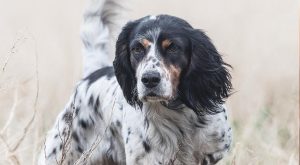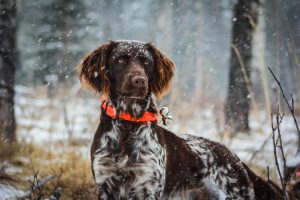Labrador Retriever, Golden Retriever, Chesapeake Bay, and Duck Tolling Retriever, Flatcoated Retriever. English Pointer. English Setter. Irish Setter. German Shorthaired Pointer. German Wirehaired Pointer/Retriever. Griffon. Epagneul Breton. Brittany Spaniel. English Spaniel. Welsh Spaniel. Cocker Spaniel… The list goes on. No shortage of choices. It is amazing how many different hunting dog breeds have been developed in the last few centuries.
A very interesting series of podcasts is called Hunting Dog Confidential. If you are at all interested in hunting dogs, where they came from, and how they developed into what they are today, Season 1 covers them all: Hunting Dog Confidential
Sometimes it’s love at first sight. And sometimes that emotion provides poor guidance. If I had followed my first impulse, I would have looked for an English Setter, based on this photo alone (I hope SportDog forgives me for stealing their photo from an ad in the Pheasants Forever magazine).

I needed some criteria to narrow down the playing field, and to insert a modicum of objectivity into the process.
When it comes to hunting of small game and birds with a shotgun, the dogs used by the majority of hunters can be roughly divided into three categories: those mostly interested in work after the shot, also known as retrieving; those known mostly for their work before the shot, finding the game, and pointing or flushing it; and those that show a more or less natural aptitude for both. There are big grey areas between these categories, and many breeds that the average guy wouldn’t even consider for these task would actually perform admirably. But most would admit that an English Setter would look out of place in a duck blind, and a Labrador Retriever might be not the best choice for a stubble field partridge hunt.
With the image that beautiful setter still in my head, and the proverbial easy-going, easy-trainable nature of a retriever in the back of my mind, it would have to be neither of them. My dog would have to be as much at ease in my tiny duck boat as in a coulee cruising for sharpies and pheasants, or running an alpine ridge looking for ptarmigan; poking around for ruffies in thick cover, or lying on his pillow in the living room enjoying a quiet weekend. Even tagging along on long runs while I train for an ultra, although pretty much any dog would outlast me. Finding game, retrieving game, and good around the house. Although September can still be brutally hot, being able to cope with the cold of late fall and winter would be more important. Shorthaired dogs were out.
Taking out the specialists on either side of the spectrum still left a big pool to choose from. Pointer or flusher? Pointer for me. I feel I hunt fairly open country more than I do thick cover, where a flusher like a Springer would shine. Close or wide-ranging? Closer would be better. I like to keep my eyes and ears on the dog, and like it if he (or she) keeps in touch with me as well. And while a point 400 yards away on a stubble field can be reached with a quick dash, the same distance across a coulee, or down (or up!) a steep slope above the trees might just be too much to deal with (getting old, I know). Likes water? Yes, absolutely. Poking around the marshes on foot or in my little duck boat when the weather is still nice, is great fun! Size? Big enough to retrieve an occasional goose and deal with deep snow, but light and agile enough to follow me into sheep and ptarmigan country.

Throw into the decision mix things like looks (totally subjective), proximity of breeders, breeds that buddies own and their opinions, and first-hand experience with the breed narrowed it down to two.